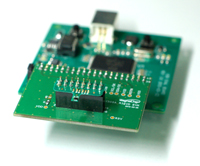By Harald Poesch, Product Manager for Motion Control Motors, USA – Siemens Industry, Inc.
Permanent magnet synchronous motors offer significant advantages on high energy consuming and high dynamic applications

Newly developed mechatronic applications such as this integrated electrohydraulic pump motor, as used on a plastics injection molding machine.Permanent magnetic synchronous motors have been in use on machine tools and other production machinery for many years, owing to their reliable performance, durability, relatively low cost and electrical stability. These motors have been the standard in the machine tool industry for many decades, used on the spindle, worktable rotation, ways and part articulation, in both rotary and linear applications of controlled motion. With the advent of the machine tool robot for materials handling, workpiece and tooling changes, high-precision load/unload functions and more, the use of these motors has grown exponentially over the years. Behind the cutting theater, they’re also found on the chip conveyor, hydraulic manifold, oil reservoir and coolant pumps.
Likewise, in the production machine realm, plastics/rubber molding and extrusion, papermaking, packaging, textiles, ceramic, glass, woodworking and countless other pieces of equipment have utilized these motors for motion control.

Further, the essential operational principle of a permanent magnet in the rotor assembly, generating a steady magnetic field instead of the short circuit current found on asynchronous induction motor designs, has yielded many advantages for the machine designer, builder and aftermarket alike. These advantages include compact form with high torque density and less weight, higher continuous torque over a wider range of speeds, lower rotor inertia, higher dynamic performance under load, higher operational efficiencies with no magnetizing current and the corresponding absence of heat due to current in the rotor, low torque ripple effect, more robust performance compared to DC motors, good cos phi (our European term for power factor) and ultimately, better drive utilization.
The challenges have been escalating costs of raw materials due to certain economic factors in the world market, though recent REM finds here in America and elsewhere may impact that situation greatly in the future. Plus, more technical aspects such as limited speed ranges in field applications and degradation due to counter voltage created by the magnets, where normally an encoder for commutation is deemed necessary, along with the inevitable limit overload condition, are being continuously addressed by the manufacturers.
New market areas are emerging, however, where the use of permanent magnetic (PM) motors are showing great promise. These applications involve the use of PM motors for increasing machine productivity with better operational efficiencies. One such example is the servo pump, where a mechatronic analysis concluded substantial energy savings and operational improvements could be realized, with the additional benefit of environmental upsides, from the application of a PM motor on the hydraulic oil reservoir, replacing a variable capacity pump with a servo. Essentially, the pump motor only runs when the conditions of the machine mechanics warrant. The long-standing presumption of continuous motor operation was no longer necessary. By use of a PM motor and direct drive technology, up to 50 percent savings are being realized on new and retrofit machines alike, with the obvious further advantage of eliminating mechanical components such as the gearbox.
Permanent magnetic synchronous torque motors typically have 30 to 60 percent higher torque capacity and 30 percent better torque utilization with faster acceleration and deceleration, compared to asynchronous induction type motors and, once again, this has proven advantageous in the field, particularly with machine tools and other metalworking production equipment where the rapid traverse function is critical to maintaining higher productivity. In German, we say Nebenzeit for the concept of downtime and, in today’s fast-paced, often unattended machining applications, elimination of that condition is an absolute must. There is also significantly higher response and the absence of the “slip” phenomenon with PM motors. In the higher power ranges, these motors are also showing a significantly longer use life, owing to the greater degree of rotor tension compensation. In other words, the reduction of backlash (hysteresis) and the maintaining of precise position are better achieved, whether under load or not. From the magnetic perspective, this condition derives from the combination of a larger air gap and smaller radial magnetic forces, with lower inertia moment and high short-term overload capacity with maintenance of desired torque.

The drive technology improvements have likewise lobbied for increased use of PM motors in application, as spindle motion precision and accuracy in a machine tool, for example, are directly dependent on the intelligence in the drive. Likewise, the complex current calculations for higher speed and rotor pole pair position identification are being made in the drive for use with simpler encoders or even encoderless configurations in the machine.
In conclusion, the advancements in magnetics configuration, coupled with the higher levels of intelligence in drives technology, are opening new applications for PM magnets every day. While the asynchronous induction motor is far from obsolete, especially with the advancements currently in variable frequency drives and inverters, used on various phase configurations.
Somewhere, both Farraday and Tesla are smiling.
Harald Poesch is the product manager for motion control motors in the USA for Siemens Industry. He holds a degree in communications engineering from the University of Applied Science in Cologne, Germany and has worked for Siemens since 1999, serving as an applications engineer for motion control in Germany, manager of the motion control applications team for production machines in Osaka and Tokyo, Japan, plus his current responsibility, managing the company’s SIMOTICS motors for motion control brand families in the USA. For further information on servo motors or torque motors using advanced magnetics, please contact:
Siemens Industry, Inc.
Drive Technologies — Motion Control
390 Kent Avenue
Elk Grove Village, IL 60007
Phone: 847-640-1595
Fax: 847-437-0784
www.usa.siemens.com/motioncontrol
SiemensMTBUMarCom.sea@siemens.com


